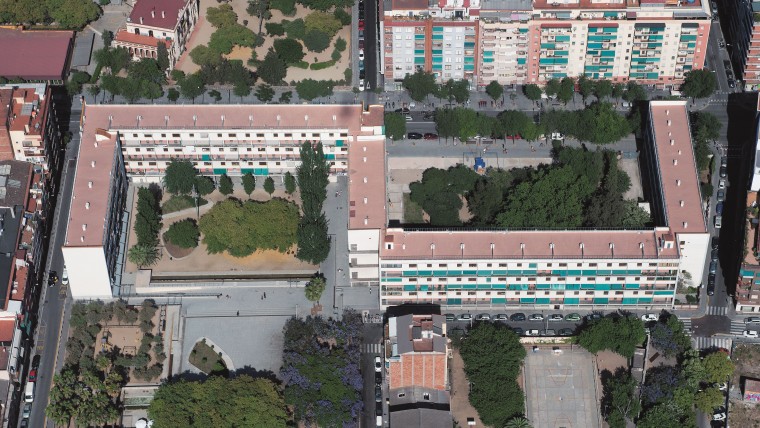
Hidden among Sant Andreu’s streets there is a block of workers’ flats that today are a small treasure: the Casa Bloc. Five S-shaped buildings , designed by the Catalan Artists and Professionals Group for Progress in Contemporary Architecture (GATCPAC) who broke away from the concept of social housing and came to epitomise rationalist architecture in the 20th century.
Rationalist progress
During the Second Spanish Republic, architects from the Group of Catalan Architects and Technicians for the Development of Contemporary Architecture (GATCPAC) designed the Casa Bloc, a very innovative social project that was embodied in five interlinked blocks in an S shape with 207 dwellings. This pioneering building stands as one of the most representative icons of rationalist architecture in Catalonia. It was a very innovative social project for its time as it meant integrating functional housing into the urban environment designed as minimum standard dwellings for workers, who until then had lived in the slums in the outskirts of the city. Its construction was promoted by the Generalitat of Catalonia, which commissioned the Group of Catalan Architects and Technicians for the Development of Contemporary Architecture (GATCPAC) to build it. The purpose of the building was to provide decent housing for the working population. The great wave of immigrants coming to the city in search of work had highlighted the serious shortage of housing for workers. The president Francesc Macià was responsible for placing the first stone of the Casa Bloc on 13 March 1933. The result was a set of five blocks in an S shape containing 207 flats between 55 and 77 m². The project incorporated optimum ventilation and lighting for all homes. The interior spaces were allocated to public services such as children’s play areas, gardens, nurseries, libraries, consumer cooperatives and workers’ clubs. Unfortunately, the outbreak of the Spanish Civil War and the establishment of the Franco regime prevented the Republican project from being implemented, which would have contributed to improving the living conditions of the working class. During the Spanish Civil War, frequent bombings in the Sant Andreu area led to the installation of an anti-aircraft machine gun on the roof of Casa Bloc. Forces of the Army Corps of Navarra stayed in the barracks in Sant Andreu and the Casa Bloc, which had been left unfinished when the war broke out.
A 1930s flat
The Disseny Hub de Barcelona has renovated one of the flats as a flat-museum, restoring the original hydraulic paving, the foldable doors (taken from other flats in disuse), the economical kitchens, the laundry with shower, separate toilet, and even original 1930s furniture. A flat-museum you can visit to see how rationalist architecture thought about functional houses that would bring dignity to the harsh living conditions of workers in Sant Andreu.




Cultural heritage
-
Sant Andreu
Sant Andreu
-
- Phone number
- (Dm a dv: 10 a 13h i Dj: 10 a 13h i 15 a 17:30h): 932566801
-
- Web
- http://www.museudeldisseny.cat/ca/exposicio/pis-museu-de-la-casa-bloc-habitatge-111 Open in a new window
-
- E-mail
- museudeldisseny@bcn.cat
-
- Titularity
- Public center
- Address:
- Passeig de Torras i Bages, 91
- Districte:
- Sant Andreu
- Neighborhood:
- Sant Andreu
- City:
- Barcelona
Timetable
| Dies | Hores | Preus |
|---|---|---|
| dissabtes | a les 11:00 h | Entrada general: 5 € Visites individuals 75 €. Grups no superiors a 15 persones Imprescindible reserva (mínim amb quinze dies d'antel·lació) |
Amb cadira de rodes només és accessible la planta baixa del dúplex.
Esdeveniments
If you would like to make a correction related to this activity...
LET US KNOW

